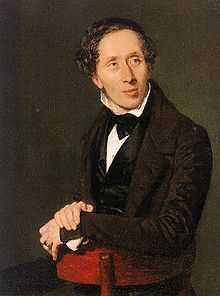Fairy Tales Told for Children (1838)
|
Andersen in 1836 | |
| Author | Hans Christian Andersen |
|---|---|
| Original title | Eventyr, fortalte for Børn. Ny Samling. Første Hefte. 1838. |
| Country | Denmark |
| Language | Danish |
| Genre | Literary fairy tale collection |
| Publisher | C. A. Reitzel |
Publication date | 2 October 1838 |
| Media type | |
Fairy Tales Told for Children. New Collection. First Booklet (Danish: Eventyr, fortalte for Børn. Ny Samling. Første Hefte, 1838) is a collection of three fairy tales by Hans Christian Andersen published in Copenhagen, Denmark by C. A. Reitzel on 2 October 1838. The collection consists of "The Daisy", "The Steadfast Tin Soldier", and "The Wild Swans".
Contents
"The Daisy" tells of happy little daisy who is taken up with a plot of earth to line the bottom of a bird cage where a lark is held captive. When he dies and is given an elaborate funeral by the children, she is cast into the road and forgotten. She alone loved the lark, took joy in his song, and felt his suffering as her own.
"The Steadfast Tin Soldier" (Den standhaftige tinsoldat) is the story of a tin soldier who loves a paper ballerina. He falls from the parlor window, and, after sailing in a paper boat down a storm drain, is swallowed by a fish. Eventually he is returned to the parlor table where still stands the ballerina. A boy throws the soldier into the fire and a draught carries the ballerina to his side. They perish together; he is melted into a tin heart.
In "The Wild Swans" (De vilde svaner), a princess mutely undergoes the most dreadful trials in order to free her eleven brothers from a spell cast by an evil queen. When suspicions are aroused that she is a witch, she is sentenced to death but rescues her brothers at the last moment. Able then to speak, she tells her story and the king marries her.
Background

Andersen became an international celebrity with the publication of his novel The Improvisatore (1835) and Fairy Tales Told for Children, his first collection of fairy tales published in three booklets between 1835 and 1837. The collection consists of nine tales that includes "The Tinderbox", "The Princess and the Pea", "Thumbelina", "The Little Mermaid", and "The Emperor's New Clothes". Andersen returned to the fairy tale genre in 1838 with another collection which, most importantly, included one tale that would change the genre forever.
Adaptations
"The Steadfast Tin Soldier" has been adapted to dramatic representation at least twice. Ballets have been composed upon the subject by Bournonville and Balanchine, and the tale has been the basis of a segment in a Disney animated film.
References
- "Hans Christian Andersen : Eventyr, fortalte for Børn. Ny Samling. Første Hefte. 1838.". Hans Christian Andersen Centre: University of Southern Denmark.
- Liukkonen, Petri. "Hans Christian Andersen". Books and Writers. Retrieved 2009-03-21.
- Tatar, Maria (2008). The Annotated Hans Christian Andersen. New York and London: W. W. Norton & Company. ISBN 978-0-393-06081-2.
- Wullschlager, Jackie (2000). Hans Christian Andersen: The Life of a Storyteller. Chicago: University of Chicago Press. ISBN 0-226-91747-9.
External links
- "The Daisy". English translation by Jean Hersholt
- “The Steadfast Tin Solder“. English translation by Jean Hersholt
- The Wild Swans. English translation by Jean Hersholt
| ||||||||||||||||||||||||||||||||||

